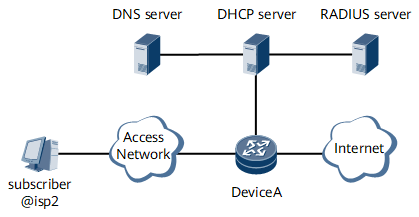Configuring DHCPv4 Proxy
Usage Scenario
To guarantee the security of a DHCPv4 server, you need to enable DHCPv4 proxy when the DHCPv4 packet sent from the NetEngine 8000 F to a user does not contain the DHCPv4 server IP address.
DHCPv4 proxy can be used in the scenario shown in Figure 1.
The DHCPv4 server can receive DHCPv4 Discovery and Request packets that are forwarded by the NetEngine 8000 F and carry the IP address of the NetEngine 8000 F as the source address.
The user can receive the DHCPv4 Offer packet with the source address being the IP address of the NetEngine 8000 F and obtain an IP address allocated by the DHCPv4 server to access the network.
- Enabling DHCPv4 Proxy
- To guarantee the security of a DHCPv4 server, you need to enable DHCPv4 proxy when the DHCPv4 packet sent from the NetEngine 8000 F to a user does not contain the DHCPv4 server IP address.
